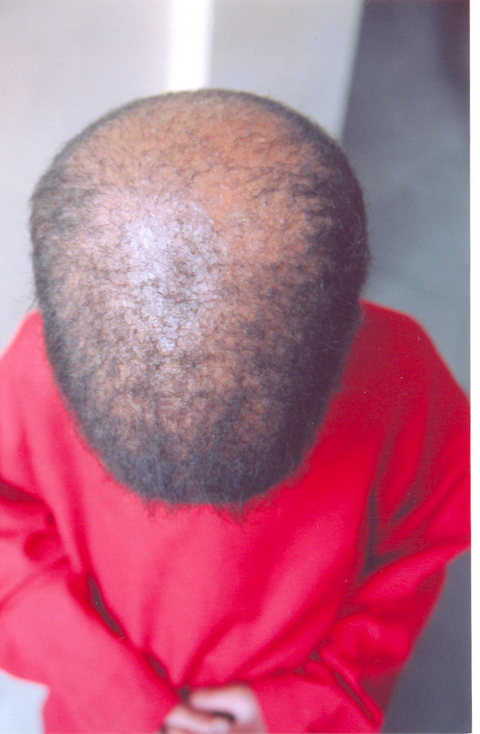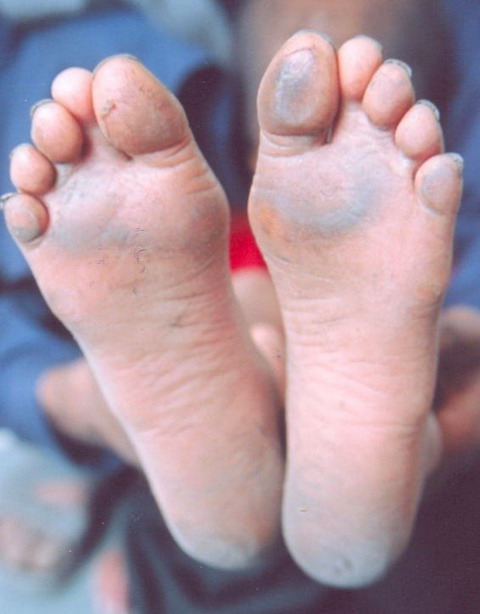Abstract
Hypohidrotic ectodermal dysplasia is a rare disorder characterized by
hypohidrosis hypotrichosis, and hypodontia. We present an 8 year old female
child with clinical picture suggestive of autosomal recessive hypohidrotic
ectodermal dysplasia with an unusual manifestation including arachnodactyl
and palmoplanter keratoderma. Introduction
Hypohidrotic ectodermal dysplasia, also known as Christ-Siemen-Touraine
syndrome is an X-linked recessive disorder. The full expression of the
disorder occurs mainly in males; females serve as carrier of the genetic
defect with a small fraction presenting with minimal to significant clinical
findings [1]. The existence of autosomal
recessive form of the disorder has been proposed on the basis of the
presence of severely affected females with unaffected parents in highly
consanguineous families [2]. The syndrome is
characterized by congenital dysplasia of one or more ectodermal structures
and includes defective hair follicles, anodontia or hypodontia with conical
teeth; dry skin and unexplained high fever due to deficiency of sweat
glands. Case report An 8 year old girl born of consanguineous
marriage presented to the outpatient department of Dermatology, STD &
Leprosy of SMHS Hospital (Associated teaching hospital of Government Medical
College Srinagar) with poor hair growth and increased hair fragility since
infancy. She was not able to tolerate the heat of summer and had recurrent
episodes of unexplained high fevers. There was no history of convulsions,
recurrent upper respiratory tract infection and dysphagia. There was no
evidence of physical and mental retardation. On examination there was
diffuse alopecia with twisted dry lusterless and brittle short hair
(Fig.1).The eye brows and eyelashes were scanty and there was
hypotrichosis on rest of the body. There was ectropion of both eyes with
epiphora (Fig.2). Hypodontia with conical lower incisors were present
(Fig.3). There was no evidence of dental caries but there was
generalized xerosis with fine dry scaling which was more prominent on the
shins. Hands and feet showed arachnodactyl with diffuse palmoplanter
keratoderma (Fig.4 and 5). Nails were thin and ridged. There was no
evidence of visual and hearing impairment. Her parents and two older male
sibs were normal. The palmer skin biopsy confirmed the absence of sweat and
sebaceous glands and revealed orthokeratotic hyperkeratosis and acanthosis
of the epidermis. The Starch Iodine test on the back demonstrated lack of
sweating.
 | Fig 1:
Diffuse alopecia on the vertex with dry lusterless hair at the
margins of the scalp. |
|
 | Fig
2: Sparse eyebrows and eyelashes with ectropion of both eyes. |
|
 | Fig
3: Hypodontia with conical lower incisors. |
|
 | Fig
4: Diffuse palmer keratoderma with arachnodactyly of hands and
feet. |
|
 | Fig
5: Diffuse planter keratoderma. |
|
Discussion
Hypohidrotic ectodermal dysplasia (HED) was first described by Thurman in
1848 [3]. Majority of reported cases of HED
have been males with an X-linked recessive mode of inheritance and are known
as Christ-Siemens-Touraine syndrome [1].
Affected females are heterozygous due to one normal and one affected
X-chromosomes [1]. These carrier females are
usually asymptomatic or may express a variable phenotype of this condition
in view of random inactivation of one of the X-chromosome during early
embryogenesis [4]. There is another less
common form of HED with autosomal recessive mode of inheritance with
clinical resemblance to Christ- Siemens-Touraine [1,5].
The syndrome is characterized by impaired or absent sweating, hypotrichosis
and hypodontia. The classical facial features described include prominent
forehead and chin, sunken cheeks with saddle nose, thick everted lips and
large ears. The sparse lusterless fragile short hair is a striking feature
of the disorder. The eyebrows, eyelashes and rest of the body hair are also
sparse or totally absent. The dental abnormalities may present as hypodontia
or andontia. The presence of conical incisors and canines are
characteristic. The gums are hypoplastic with normally developed jaws. Nails
are thin, ridged and brittle. Heat intolerance or unexplained hyperthermia
occurs due to reduced or absent sweating. The Starch Iodine test
demonstrates total absence or decrease in sweating. Affected females with
X-linked recessive heterozygous inheritance, carrying one normal X
chromosomes and one affected chromosome; demonstrate sweating along the
Blasckho's lines, a phenomenon based on lionization [6].
The otorhinolaryngological features include atrophic rhinitis, crusted nasal
secretion, ozaena, recurrent upper respiratory infection, hoarseness, asthma
and hearing defect [7]. The ocular
manifestations include corneal and lenticular opacities [8].
The poor development of lacrimal, salivary and mucus glands of the
gastrointestinal tract results in conjunctivitis, xerostomia and dysphagia.
Diffuse palmoplanter keratoderma has been recent addition to the syndrome [9].
There is retardation in physical and mental development in one third of
cases. Our patient did not have the typical facies of the syndrome but had
an additional feature of ectropion, arachnodactyl and diffuse palmoplanter
keratoderma which are unusual manifestation of this genodermatosis.
References
1. Pinheiro M, Freire-Maia N.
Christ-Siemens-Touraine syndrome: a clinical and genetic study of large
Brazilian kindred. Am J Med Genet 1979; 4: 113- 122.
2. Passarge E, Nuzum CT,Schubert WK. Anhidrotic ectodermal dysplasia as an
autosomal recessive trait in an inbred kindred. Humangenetik 1966; 3: 181-
185.
3. Thurman J. Two cases in which the skin, the
hair and the teeth were very imperfectly developed. Proc R Chir Soc.1848;
31:71.
4. Lyon MF. X-chromosome inactivation and
development patterns in mammals. Biol Rev.1972; 4:113.
5. McKusick VA. Mendelian Inheritance in Man: Catalogs of Autosomal
Dominant, Autosomal and X-linked phenotypes.8th ed. Baltimore,Md:The Johns
Hopkins University Press;1988.
6. Happle R, Frosch
PJ. Manifestation of the lines of Blaschko in women heterozygotes for
X-linked hypohidrotic ectodermal dysplasia. Clin Genet 1985; 27: 468- 471.
7. Al-Jassim AH, Swift AC. Persistent nasal crusting due to hypohidrotic
ectodermal dysplasia. J Laryngol Otol 1996; 110: 379- 382.
8. Kline AH, Sidbury JB, Rhicter CP. The occurrence of ectodermal dysplasia
and corneal dysplasia in one family. J Pediatr 1959; 55: 355- 366.
9. Sandhu K , Handa S, Kanwar A J. Anhidrotic ectodermal dysplasia with
palmoplantar keratoderma: an unusual presentation. Int J Dermatol 2007; 46:
631- 633.© 2010 Egyptian Dermatology Online
Journal | 




